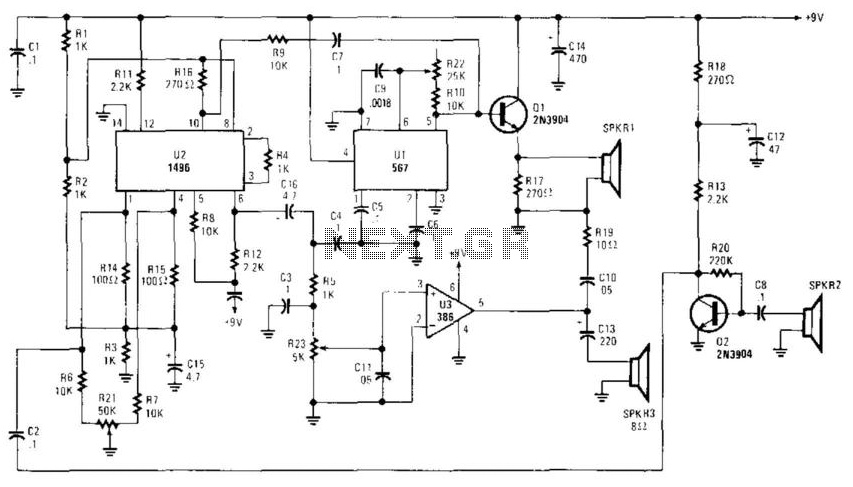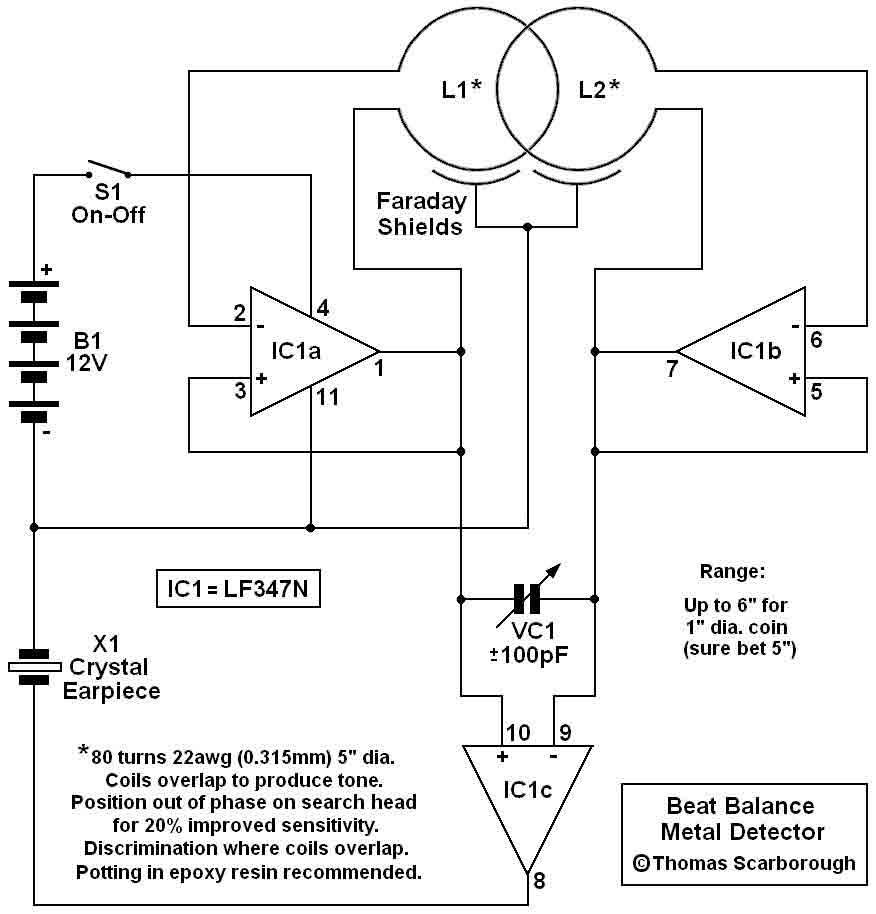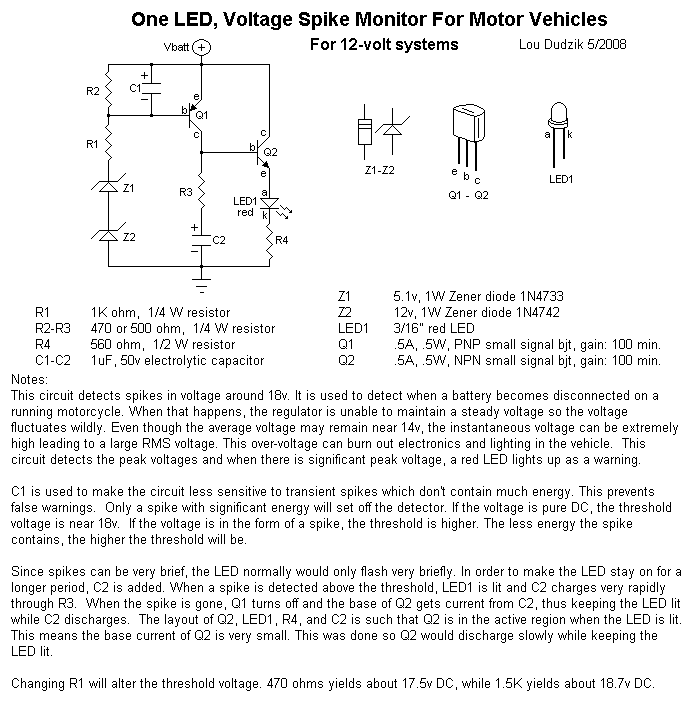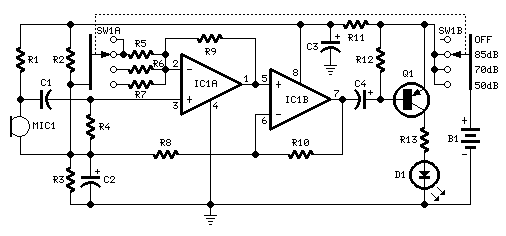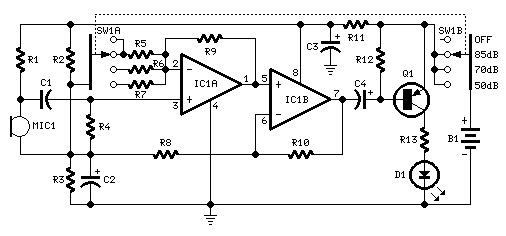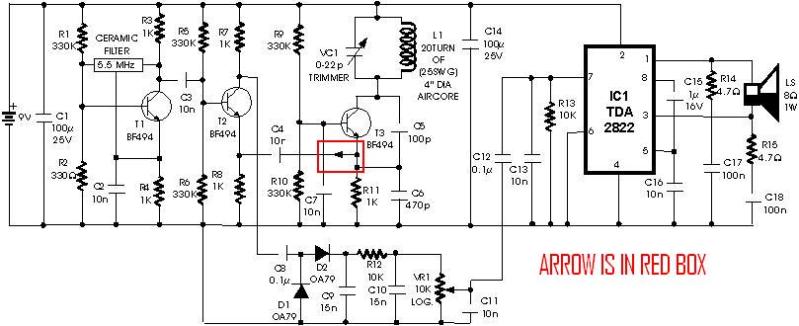
metal detector with MC AT90S2313
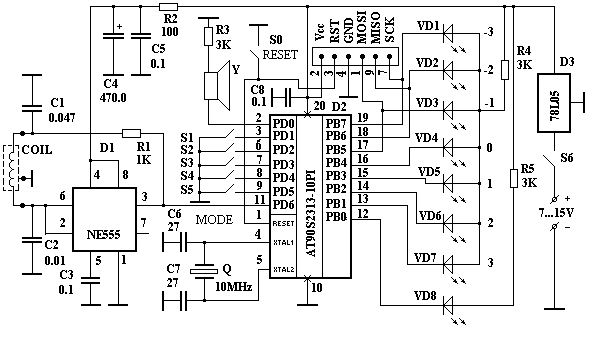
It's a simple metal detector design that has quite good characteristics. The principle of operation differs from classic schemes (BFO, transmit-receive known as "two-boxes" metal detector, inductive). The dynamic mode is used to find targets in an interference environment. It is known from the theory of signal filtration that if the signal shape is determined, an optimal filter can be constructed—the best one for extracting the signal with maximum signal-to-noise ratio. This filter is known as an optimal matched filter.
In this device, a digital optimal matched filter is realized as part of the microcontroller software. The filter parameters are optimized for effective ferro- and non-ferro target detection at a sensor velocity of 0.5-1.0 m/s. Features of the Metal Detector include: Power supply 4.5-6V; DC consumption 15 mA; indication sound; 8 LEDs; modes static or dynamic; discrimination ferro/non-ferro. Switches controlled (versions V1.9 and V2.0 of firmware): S0: reset device; S1: reserved; S2: on - threshold high, off - threshold low; S3: measuring time on - 30ms, off - 120ms; S4: self-tuning on/off (in dynamic mode only); S5: mode on - static, off - dynamic.
The metal detector circuit employs a microcontroller to implement the digital optimal matched filter, which plays a critical role in enhancing the detection capabilities. The microcontroller processes the incoming signals from the sensor, applying the optimal matched filter algorithm to maximize the signal-to-noise ratio. This is particularly important in environments with high electromagnetic interference, where traditional detection methods may struggle.
The power supply requirements are modest, operating within a range of 4.5 to 6 volts, with a low current draw of 15 mA. This allows for the use of standard battery configurations, making the device portable and practical for field use. The indication system consists of an auditory alert and eight LEDs, providing both visual and auditory feedback to the user regarding the presence of detected metal objects.
The device features multiple operational modes: static and dynamic. In static mode, the detector can be used for stationary scanning of an area, while dynamic mode allows for movement across the terrain, adapting to varying conditions and target types. The discrimination capability enables users to differentiate between ferrous and non-ferrous metals, enhancing the utility of the detector in various applications.
Control of the device is facilitated through a series of switches, allowing users to customize settings according to their needs. The options include resetting the device, adjusting the detection threshold, configuring measuring time intervals, and toggling self-tuning capabilities in dynamic mode. These features provide flexibility and adaptability, catering to different user preferences and operational scenarios.
Overall, this metal detector design represents a sophisticated integration of digital signal processing techniques with practical hardware considerations, resulting in an effective tool for metal detection in diverse environments.It's a simple metal detector design that has the quite good characteristics. the principle of operation which one differs from the classic schemes (BFO, transmit-receive known as "two-boxes" metal detector, inductive). The dynamic mode is used to find targets in interference environment. There is known from theory of signal filtration that if signal shape is determined we can construct optimal filter - the best one for extracting the signal with maximum signal/noise ratio.
This filter is known as optimal matched filter.
In this device, a digital optimal matched filter is realized as part of the microcontroller software. The filter parameters are optimized for effective ferro- and non-ferro target detection at a sensor velocity of 0.5-1.0 m/s. Features of the Metal Detector include: Power supply 4.5-6V; DC consumption 15 mA; indication sound; 8 LEDs; modes static or dynamic; discrimination ferro/non-ferro. Switches controlled (versions V1.9 and V2.0 of firmware): S0: reset device; S1: reserved; S2: on - threshold high, off - threshold low; S3: measuring time on - 30ms, off - 120ms; S4: self-tuning on/off (in dynamic mode only); S5: mode on - static, off - dynamic.
The metal detector circuit employs a microcontroller to implement the digital optimal matched filter, which plays a critical role in enhancing the detection capabilities. The microcontroller processes the incoming signals from the sensor, applying the optimal matched filter algorithm to maximize the signal-to-noise ratio. This is particularly important in environments with high electromagnetic interference, where traditional detection methods may struggle.
The power supply requirements are modest, operating within a range of 4.5 to 6 volts, with a low current draw of 15 mA. This allows for the use of standard battery configurations, making the device portable and practical for field use. The indication system consists of an auditory alert and eight LEDs, providing both visual and auditory feedback to the user regarding the presence of detected metal objects.
The device features multiple operational modes: static and dynamic. In static mode, the detector can be used for stationary scanning of an area, while dynamic mode allows for movement across the terrain, adapting to varying conditions and target types. The discrimination capability enables users to differentiate between ferrous and non-ferrous metals, enhancing the utility of the detector in various applications.
Control of the device is facilitated through a series of switches, allowing users to customize settings according to their needs. The options include resetting the device, adjusting the detection threshold, configuring measuring time intervals, and toggling self-tuning capabilities in dynamic mode. These features provide flexibility and adaptability, catering to different user preferences and operational scenarios.
Overall, this metal detector design represents a sophisticated integration of digital signal processing techniques with practical hardware considerations, resulting in an effective tool for metal detection in diverse environments.It's a simple metal detector design that has the quite good characteristics. the principle of operation which one differs from the classic schemes (BFO, transmit-receive known as "two-boxes" metal detector, inductive). The dynamic mode is used to find targets in interference environment. There is known from theory of signal filtration that if signal shape is determined we can construct optimal filter - the best one for extracting the signal with maximum signal/noise ratio.
This filter is known as optimal matched filter.
In our device we realized digital optimal matched filter as part of microcontroller software. The filter parameters are optimized for effective ferro- and nonferro targets detection on 0.5-1.0 m/s velocity of sensor. Features of the Metal Detector: Power supply 4.5-6V; DC consumption 15 mA; Indication sound + 8 LEDs; Modes static or dynamic; Discrimination ferro/non-ferro.
Switches controled (versions V1.9 and V2.0 of firmware): S0: reset device; S1: reserved; S2: on - threshold hight, off - threshold low; S3: measuring time on - 30ms, off - 120ms; S4: selftuning on/off (in dynamic mode only); S5: mode on - static, off - dynamic.
